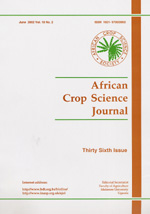
|
African Crop Science Journal
African Crop Science Society
ISSN: 1021-9730
EISSN: 1021-9730
Vol. 5, No. 1, 1997, pp. 93-98
|
 Bioline Code: cs97012
Bioline Code: cs97012
Full paper language: English
Document type: Symposium
Document available free of charge
|
|
|
African Crop Science Journal, Vol. 5, No. 1, 1997, pp. 93-98
| en |
A green revolution frustrated: lessons from the Malawi experience
Carr, S. J.
Abstract
High population density, small farm size and a monomodal rainfall pattern
are the main determinants of smallholder farming patterns in Malawi. With
over 70% of farmers having total land holdings of less than 1 ha, the
farming system is dominated by continuous cropping with maize without
fallow and very little rotation. Consequently the nutrient capital of the
soil is being depleted and yields are declining. For many years, the
government's response to this situation has been to intensify technology
based on the use of hybrid maize and inorganic fertilisers. Originally, the
entire effort of the extension staff was devoted to this strategy,
supported by subsidies on credit, input and output prices. As a result, the
use of fertiliser and hybrid seed expanded rapidly and, in the 1992/93
season, this technology had been adopted on almost half of the total maize
area. Yields of fertilised hybrid maize are presently about three time
those obtained under traditional practices, and a number of international
observers classified Malawi's experience as an example of an African "Green
Revolution". Predictions were that by the end of the decade up to 70% of
the maize area would be fertilised and planted with hybrid seed. Such
claims and predictions took inadequate account to the cost to the tax-payer
of maintaining these distortions once the technology was adopted on a
large-scale. Subsidies have had to be dropped, both input and output
markets have been liberalised and the currency has been floated. The result
has been that the small holder sector in 1995/96 was able to purchase
hybrid seed sufficient to plant only 7% of the maize area, whilst per
capita sales of fertiliser for use on maize were lower than they were
fifteen years ago. The rapid rise in the price of fertiliser has been
unmatched by a rise in grain prices because these are controlled by the
purchasing power of a poor population. Increasing fertiliser use has been
the engine of growth of agricultural production in much of the world during
the past thirty years. The World Bank, among others, has stressed the need
for a rapid increase in fertiliser use in Africa if its expanding
population is to be fed. It has stressed that the removal of subsidies, the
liberalisation of markets and sound currency exchange policies are the
vital pre-requisite for achieving this goal. The Malawian experience
provides ominous indications that such policies may not achieve their
desired results, and that Sub-Saharan Africa may only be able to make
limited use of the fertiliser technology which has transformed so much of
the world's agriculture. This paper provides a detailed analysis of the
figures and factors involved in this frustrated Green Revolution and points
to their relevance to other countries in the region.
Keywords
Fertiliser subsidies, maize, market liberalisation, Sub-Saharan Africa
|
| |
| fr |
Carr, S. J.
Résumé
Une forte densite de population, des petites tailles des fermes et un
regime de precipitation monomodal sont les determinants les plus importants
pour les petits agriculteurs au Malawi. Avec plus de 70% des agriculteurs
qui possedent moins que 1 ha, les systemes agricoles sont domines par une
culture continue du mais sans friche et avec peu de rotation. En
consequence, la reserve nutritive du sol et les recoltes diminuent. Pendant
plusieurs annees, le gouvernement a intensifie la technologie en se basant
sur le mais hybride et des engrais inorganiques. Les efforts de
vulgarisation se sont concentres a cette strategie, supportee par des
subventions de credit, et des prix d'achat et de vente. Le resultat etait
que l'emploi des engrais et des graines hybrides augmentait rapidement et
dans la saison de 1992/93 cette technologie a ete adoptee par presque la
moitie de la zone de production de mais. Les recoltes du mais hybride
augmentaient d'environ trois fois celle obtenue par les pratiques
traditionnelles et plusieurs observateurs internationaux ont classifie
l'experience de Malawi comme l'exemple "d'une revolution verte Africaine".
On a pronostique qu'a la fin de la decennie, plus de 70% de la zone de
production de mais serait plante avec le mais hybride. Ces predictions
tenaient insuffisamment compte des depenses des contribuables pour
maintenir cette distortion des que la technologie serait adoptee a grande
echelle. Les subventions devaient baisser, les marches d'intrants et de
produits ont ete liberalises, et le monnaie flottait. En consequence, en
1995/96 les petits agriculteurs etaient capable de seulement planter 7 % de
la zone de production de mais pendant que la vente des engrais par capita
etait plus bas qu'il y a 15 ans. Les prix des engrais n'augmentaient pas
simultanement avec le prix du mais parce qu'ils sont controles par la
capacite d'achat de la pauvre population. L'emploi eleve des engrais etait
le moteur devant le developpement de la production agricole dans la plupart
des pays pendant les 30 annees passees. La banque mondiale, parmi d'autres,
a stigmatise le besoin d'une augmentation rapide de l'emploi des engrais en
Afrique pour nourrir sa population expansive. Elle a insiste sur la
reduction des subventions, une liberalisation du marche et une politique
saine de taux de change comme conditions vitales pour atteindre les
objectifs. L'experience Malawienne donne la preuve que cette politique ne
peut pas atteindre les resultats desires et que l'emploi des engrais en
Afrique sub-Saharienne est limite. Cet article donne une analyse detaillee
des parametres qui se rapportent a cette revolution verte ratee et des
lecons a tirer pour d'autres pays dans cette region.
Mots Clés
Des subventions d'engrais, le mais, la Banque Mondiale, l'Afrique sub-Saharienne
|
| |
© Copyright 1997 - African Crop Science Society
|
|
